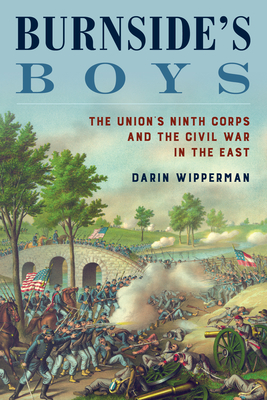Burnside's Boys: The Union's Ninth Corps and the Civil War in the East

Burnside's Boys: The Union's Ninth Corps and the Civil War in the East
Unique among Union army corps, the Ninth fought in both the Eastern and Western theaters of the Civil War. The corps' veterans called their service a "geography class," and others have called the Ninth "a wandering corps" because it covered more ground than any corps in the Union armies. With the same attention to detail that he gave to the First Corps in First for the Union, Darin Wipperman vividly reconstructs life--and death--in the Ninth Corps. The roots of the Ninth Corps lay in the early 1862 coastal expeditions in the Carolinas under Ambrose Burnside. After this successful campaign--a master class in Civil War amphibious warfare that turned Burnside into a star--Burnside's units coalesced into a corps, part of which reinforced Pope's Army of Virginia at Second Bull Run during the summer of 1862. The Ninth fought with the Army of the Potomac in the Maryland campaign in September 1862, first at the Battle of South Mountain and then, in its most famous action, at Antietam, where it suffered 25 percent casualties attempting to seize what became known as Burnside's Bridge. Three months later, the corps was lightly engaged at the Battle of Fredericksburg, during which Burnside commanded the entire Army of the Potomac. After the disaster of Fredericksburg, the Ninth--again under Burnside--spent much of 1863 in the West with the Army of the Ohio, performing occupation duty in Kentucky and then in Grant's campaign to take Vicksburg, Mississippi. It fought in Tennessee and helped take Knoxville before returning East, a shell of itself thanks largely to disease. Reorganized, the Ninth joined Grant's Overland Campaign in Virginia, fighting--with horrifying losses--at the Wilderness and Spotsylvania. It joined the siege of Petersburg, including the infamous Battle of the Crater in July 1864, and remained at Petersburg through the end of the war, where it participated in the assault that broke the siege in April 1865, forcing Lee's army into retreat, and final defeat, at Appomattox. From the Carolinas to Maryland, from Kentucky, Mississippi, and Tennessee to Virginia, the Ninth Corps sacrificed for the Union--and burnished its place in the annals of the American Civil War.
PRP: 255.00 Lei
Acesta este Pretul Recomandat de Producator. Pretul de vanzare al produsului este afisat mai jos.
229.50Lei
229.50Lei
255.00 LeiIndisponibil
Descrierea produsului
Unique among Union army corps, the Ninth fought in both the Eastern and Western theaters of the Civil War. The corps' veterans called their service a "geography class," and others have called the Ninth "a wandering corps" because it covered more ground than any corps in the Union armies. With the same attention to detail that he gave to the First Corps in First for the Union, Darin Wipperman vividly reconstructs life--and death--in the Ninth Corps. The roots of the Ninth Corps lay in the early 1862 coastal expeditions in the Carolinas under Ambrose Burnside. After this successful campaign--a master class in Civil War amphibious warfare that turned Burnside into a star--Burnside's units coalesced into a corps, part of which reinforced Pope's Army of Virginia at Second Bull Run during the summer of 1862. The Ninth fought with the Army of the Potomac in the Maryland campaign in September 1862, first at the Battle of South Mountain and then, in its most famous action, at Antietam, where it suffered 25 percent casualties attempting to seize what became known as Burnside's Bridge. Three months later, the corps was lightly engaged at the Battle of Fredericksburg, during which Burnside commanded the entire Army of the Potomac. After the disaster of Fredericksburg, the Ninth--again under Burnside--spent much of 1863 in the West with the Army of the Ohio, performing occupation duty in Kentucky and then in Grant's campaign to take Vicksburg, Mississippi. It fought in Tennessee and helped take Knoxville before returning East, a shell of itself thanks largely to disease. Reorganized, the Ninth joined Grant's Overland Campaign in Virginia, fighting--with horrifying losses--at the Wilderness and Spotsylvania. It joined the siege of Petersburg, including the infamous Battle of the Crater in July 1864, and remained at Petersburg through the end of the war, where it participated in the assault that broke the siege in April 1865, forcing Lee's army into retreat, and final defeat, at Appomattox. From the Carolinas to Maryland, from Kentucky, Mississippi, and Tennessee to Virginia, the Ninth Corps sacrificed for the Union--and burnished its place in the annals of the American Civil War.
Detaliile produsului











